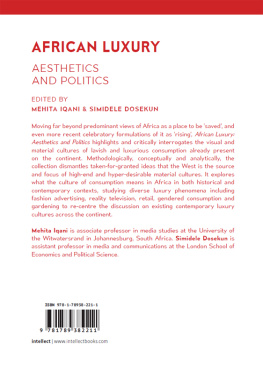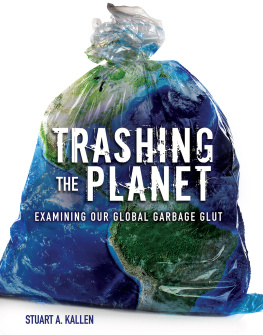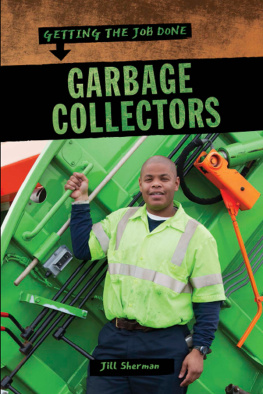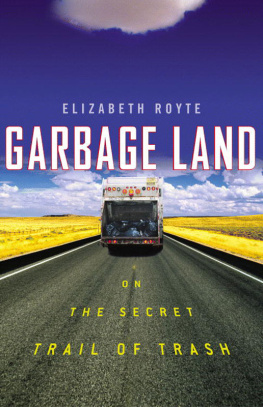GARBAGE IN POPULAR CULTURE
Garbage in
Popular
Culture
Consumption and the Aesthetics of Waste
MEHITA IQANI
Cover image: Cape Mongo (2015) by Francois Knoetze.
Courtesy of Francois Knoetze.
Published by State University of New York Press, Albany
2020 State University of New York Press
All rights reserved
Printed in the United States of America
No part of this book may be used or reproduced in any manner whatsoever without written permission. No part of this book may be stored in a retrieval system or transmitted in any form or by any means including electronic, electrostatic, magnetic tape, mechanical, photocopying, recording, or otherwise without the prior permission in writing of the publisher.
For information, contact State University of New York Press, Albany, NY
www.sunypress.edu
Library of Congress Cataloging-in-Publication Data
Names: Iqani, Mehita, author.
Title: Garbage in popular culture : consumption and the aesthetics of waste / Mehita Iqani.
Description: Albany : State University of New York Press, [2020] | Includes bibliographical references and index.
Identifiers: LCCN 2020001181 (print) | LCCN 2020001182 (ebook) | ISBN 9781438480176 (hardcover) | ISBN 9781438480190 (ebook)
Subjects: LCSH: Consumption (Economics)Social aspects. | Refuse and refuse disposalSocial aspects.
Classification: LCC HC79.C6 I63 2020; (print) | LCC HC79.C6 (ebook) | DDC 306.3dc23
LC record available at https://lccn.loc.gov/2020001181
LC ebook record available at https://lccn.loc.gov/2020001182
10 9 8 7 6 5 4 3 2 1
CONTENTS
1
GLOBALIZATION, CONSUMPTION, and MEDIA
Why Rubbish Matters |
2
AGENCY and ACTION
Recycling Consumer Subjectivity through Waste |
3
HEDONISM and LUXURY
Waste and Its Traces in Narratives of Pleasure |
4
DEVASTATION and AFFECT
Seeking Consumption in Oil and Plastic Trashscapes |
5
PUBLIC OBJECTS, WASTED SUBJECTS, UNCERTAIN FUTURES |
ILLUSTRATIONS
ACKNOWLEDGMENTS
The academics, artists, environmentalists, writers, musicians, entrepreneurs, and critical thinkers I am lucky to have in my life and call my friends, students, and colleagues have shaped this book more than they know. There are too many to name, but I am deeply grateful to everyone who talked with me about the subject matter in this book; helped me shape my thinking and arguments; shared material, case studies, and ideas; encouraged me to start and stay with the writing; or inspired me in some way or other to capture into words the ideas in the pages that follow. A special thank you to my friends (or should I say, family) at Breezeblock, my neighborhood caf in Brixton, Johannesburg, where I wrote and edited huge swathes of this book, buoyed by excellent coffee, food, sunshine in the winter, and what felt like a bottomless well of kindness from Keke Mamaleshoane and Azwi Netshirembe, in particular.
I participated in the Sugarman workshop on Toxicity and Detritus, which took place in Durban in 2016, organized by colleagues at the University of the Witwatersrand and the University of Michigan, where I presented some early work relevant to this book.
I was privileged to have had the opportunity to work on the manuscript for this book during academic writing residencies at the Bellagio Center of the Rockefeller Foundation in 2018 and Makerere University in Kampala, Uganda in 2019, through the American Council for Learned Scholars African Humanities Programme. I am grateful to staff and fellow residents at both institutions for their support and intellectual generosity during my time with them. I am also grateful to the South African National Research Foundation for funding support during the time of writing this book.
I wrote a significant part of this book in Lamu, Kenyaa place that generously gave me both much inspiration and many new friends. I hope that somehow the work presented here can contribute in some tiny way to protecting places like it.
I would like to thank all the photographers, artists, activists, and public sector workers who gave explicit permission for me to include their images in this book, or who put their work into the public domain for fair use by researchers like me. Special thanks to Francois Knoetze for allowing me to feature his artwork on the cover.
I would not have been able to finalize this manuscript without the efficient and reliable assistance of Gabriel Shamu.
To David du Preez: thank you for being my Besten bester. Your love and partnership are constants in an inconstant world.
I dedicate this book to all out there on the frontlines working as best they are able for their fellow human beings in the quest to protect the environment.
Globalization, Consumption, and Media
Why Rubbish Matters
Most people on the planet have two things in common, both deeply embedded in the inescapably material nature of the human condition. The first is that we aspire to accumulate or possess things that, thanks to the power of market exchange in the global neoliberal economy, most often manifest as commodities. The second is that through our use, possession, and eventual utilization of those things, we produce some form of waste, which must then be disposed of. Wherever there is consumption, there is waste.
All people, from the most impoverished to the obscenely wealthy, through the day-to-day and often automatic decisions that we make, acquire things, use them, and throw whats left of them away. To date, much critical consumer culture theory has devoted attention to questions linked to the accumulation and use of things (be they defined in the material, virtual, or experiential sense). This book aims to understand the culturally shared meanings attached to the detritus that is left behind once consumption has taken place, and thereby to expand our critical thinking both about consumption and about rubbish. By better understanding the two in relation to one another, new insights will be gleaned into the futures of consumption and material culture, the latter increasingly defined by the waste that it creates. Scholars have deployed frameworks from a wide range of disciplines in order to understand what objects mean to people, how and why they acquire and exchange them, and how their consumption practices fit into the bigger picture of a world shaped by the economics of late capitalism. In previous writing, I have contributed to these understandings by revealing the role that media texts, discourses, and narratives play in shaping popular, often taken-for-granted ideas about consumption and the individuals place and role in the neoliberal economy. Some scholars have written about the ethics of consumption and questions of environmental sustainability in relation to consumption (Harrison, Newholm, & Shaw, 2005; Guido, 2009; Barnett et al., 2010; Smart, 2010; Carrier & Luetchford, 2012; Lewis & Potter, 2013), and others have written about the role of waste and garbage in material culture studies, media studies, geography and anthropology, and cultural philosophy (as the rest of this chapter explores in detail). However, not enough theoretical work has yet been done about the role of postconsumer trash in the neoliberal age, and specifically about how that roleor those rolesare narrated in such a way as to enter the popular imagination and shape and define cultural discourse.









